
eBook - ePub
Figures and Faces
A Sketcher's Handbook
Hugh Laidman
This is a test
Condividi libro
- 160 pagine
- English
- ePUB (disponibile sull'app)
- Disponibile su iOS e Android
eBook - ePub
Figures and Faces
A Sketcher's Handbook
Hugh Laidman
Dettagli del libro
Anteprima del libro
Indice dei contenuti
Citazioni
Informazioni sul libro
Artist, illustrator, and teacher Hugh Laidman shows how simple and rewarding it can be to draw two of the most challenging of artistic subjects — the male and female figures.
A brief review of anatomical structure is followed by detailed illustrations and clear instructions for rendering line, tone, structure, and form in a variety of techniques. Explanatory drawings, practice exercises, and step-by-step photographs are used to discuss sketching, sustained and contour drawing, working with charcoal or pastels, as well as finding and posing models and drawing people of different ages and ethnic groups.
Art students to professionals will find the text's direct terminology and detailed illustrations of immense value.
Domande frequenti
Come faccio ad annullare l'abbonamento?
È semplicissimo: basta accedere alla sezione Account nelle Impostazioni e cliccare su "Annulla abbonamento". Dopo la cancellazione, l'abbonamento rimarrà attivo per il periodo rimanente già pagato. Per maggiori informazioni, clicca qui
È possibile scaricare libri? Se sì, come?
Al momento è possibile scaricare tramite l'app tutti i nostri libri ePub mobile-friendly. Anche la maggior parte dei nostri PDF è scaricabile e stiamo lavorando per rendere disponibile quanto prima il download di tutti gli altri file. Per maggiori informazioni, clicca qui
Che differenza c'è tra i piani?
Entrambi i piani ti danno accesso illimitato alla libreria e a tutte le funzionalità di Perlego. Le uniche differenze sono il prezzo e il periodo di abbonamento: con il piano annuale risparmierai circa il 30% rispetto a 12 rate con quello mensile.
Cos'è Perlego?
Perlego è un servizio di abbonamento a testi accademici, che ti permette di accedere a un'intera libreria online a un prezzo inferiore rispetto a quello che pagheresti per acquistare un singolo libro al mese. Con oltre 1 milione di testi suddivisi in più di 1.000 categorie, troverai sicuramente ciò che fa per te! Per maggiori informazioni, clicca qui.
Perlego supporta la sintesi vocale?
Cerca l'icona Sintesi vocale nel prossimo libro che leggerai per verificare se è possibile riprodurre l'audio. Questo strumento permette di leggere il testo a voce alta, evidenziandolo man mano che la lettura procede. Puoi aumentare o diminuire la velocità della sintesi vocale, oppure sospendere la riproduzione. Per maggiori informazioni, clicca qui.
Figures and Faces è disponibile online in formato PDF/ePub?
Sì, puoi accedere a Figures and Faces di Hugh Laidman in formato PDF e/o ePub, così come ad altri libri molto apprezzati nelle sezioni relative a Kunst e Kunsttechniken. Scopri oltre 1 milione di libri disponibili nel nostro catalogo.
Informazioni
Argomento
KunstCategoria
KunsttechnikenPART I/FIGURES
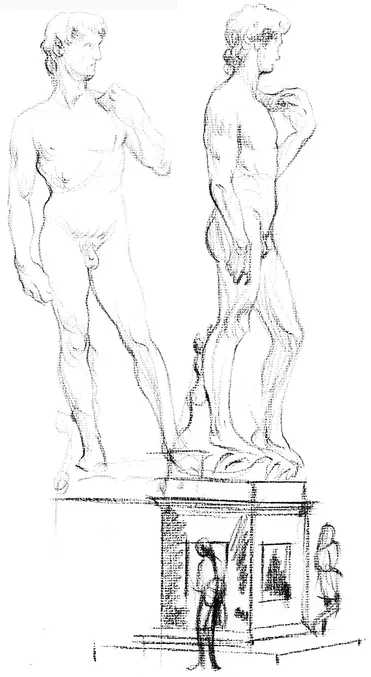
I am sketching Michelangelo’s David in the Florence Accade-mia. A busload of German tourists crowds through. The guard asks me to move. I take another position out of the traffic pattern. For the first time I realize how large David is. I draw the little girl at the foot of the pediment. I remember the story my old German art instructor told me—the top of David’s head is still unfinished. . . . I think of all the work I’ve left undone and feel a little closer to Michelangelo. I think, as I draw, I can see the sculptor chipping away.
Because I have been drawing what I have been seeing and thinking about what I have been drawing, my impression of David may be closer to indelible than the impressions of most of those German tourists.

Bones
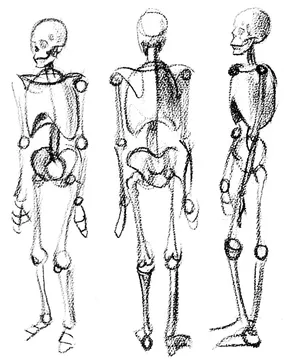
Above we have identified the major bones. It is not necessary to remember all the names, but it helps to be familiar enough with them for easy reference in the beginning. In the study of the bones, the framework of the figure, we begin to comprehend the possible degree or limit of motion of the parts of the human structure.
We can simplify the skeleton for the sake of drawing to the elements shown in the three views on the left.
At the top of page 21 are illustrations of the three main parts of the skeleton. The backbone, a series of tiny interlocked bones, connects the three parts. The important thing for the artist to remember is that the spine is a flexible column to which the three main inflexible parts are attached. The movement of these parts in relation to one another is in direct relation to the degree of flexibility of this connecting column.
The lower jaw moves in the skull, the pelvic girdle does change during childbirth, but fundamentally these three masses are static shapes.
Bearing in mind that the bones of most mammals, including the human, would fall into an untidy pile but for the fact that they are tied neatly together by an amazing structure of tendons and muscles, we will attempt a simplification of the human anatomy.
The upper arm bone (humerus) fits into a socket in the scapula, and the scapula in turn works in conjunction with the collarbone (clavicle), completing the collar around the neck. The scapula (shoulder blade) is anything but stationary, joined by clavicles right and left, one for each shoulder blade. The clavicles in turn almost meet at the front of the rib cage (sternum, or breastbone). It is traditional for the instructor to explain that the bone called the clavicle is so named because of its resemblance in shape to an ancient Latin key. This adds a bit of seasoning to an otherwise bland subject. More interesting to the artist is the fact that even in overweight people we can detect the clavicles beneath the skin and muscle.
The upper femur has a ball-like structure that fits into a socket in the pelvis.
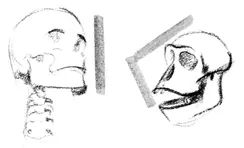
In the human, the spine has an S curve. In the gorilla, another primate, the curve of the spine is that of a C. In the head, the frontal angle of the human is classically a vertical line; that of the gorilla is at a much greater angle.
Using our simplified skeleton of the torso area, make quick sketches of the rib cage, pelvic area, and the skull, connected by the spinal column. The upper section of the rib cage appears wider at the top than it actually is. This is due to the


scapulae and collarbones encircling the upper area around the shoulders and neck. The humerus, fitting into this area of scapula and clavicle, helps to give the appearance of a broader upper rib cage. Between the rib cage area and the pelvic area is the epigastrium. Keeping these facts in mind makes it a little simpler to sketch the human figure. Once we have general shapes of these three main masses—skull, rib cage, and pelvic girdle—well in mind, we can attack arms and legs with more assurance.
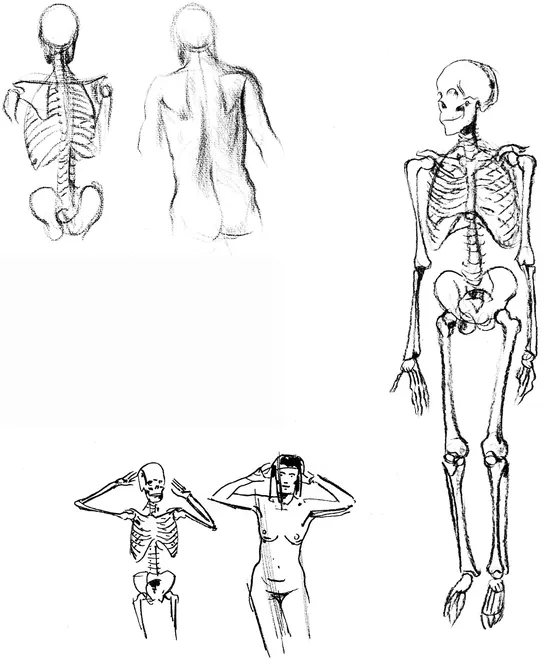
Viewing the figure from the rear, we find a bony area in the vicinity of the small of the back. The bone structure of the arm has certain similarities to that of the leg. The humerus, the single bone of the upper arm, extends to the elbow, at which point two bones, the radius and the ulna, continue to the wrist and hand. In the case of the legs, we have a socket in the pelvis that accepts the femur, which in turn extends to the knee, where we have two bones, the fibula and tibia, extending to the ankle and foot. Draw a couple of thumbnail sketches, first of the skeleton, then of the figure, in similar poses.
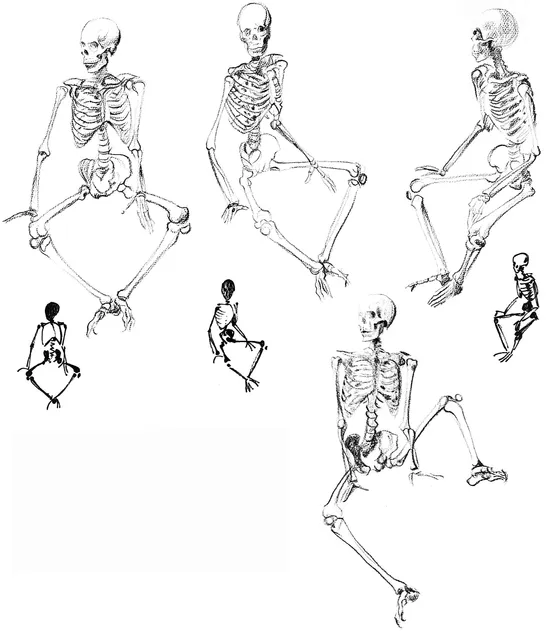
By the time you’ve study-sketched all my lounging skeletons on these three pages, you’ll be better prepared to draw a figure. Make thumbnail sketches of these, bearing in mind what has been said of the skeleton and its functions so far.
There is no formula for producing instant artists. The nearest thing is the simple procedure in which the student thinks about every mark he makes on his paper in relation to the subject that he intends to draw and the purpose he had in drawing it in the first place.
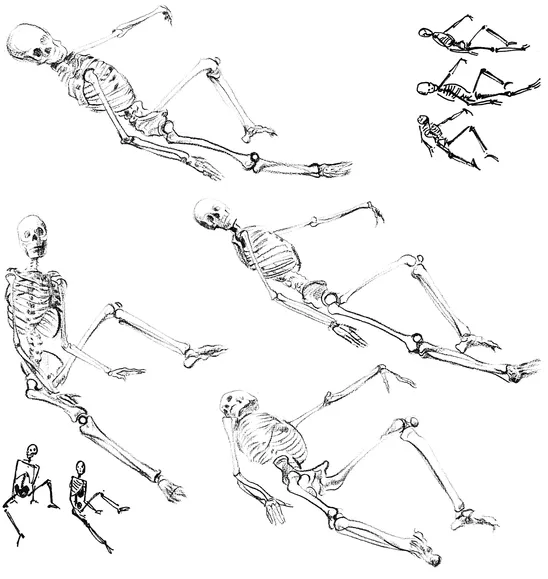
The top three seated skeletons on page 24 are drawn from a skeleton placed in one position. I have merely moved from one vantage point to another to illustrate the variety of drawings possible from a single position of the model. The skeleton at the bottom of page 24 and the lower left skeletons on page 25 are again in one position, but I changed my drawing situation. The remaining drawings on page 25 are of a skeleton lying down on a couch, drawn once again from different viewing points.
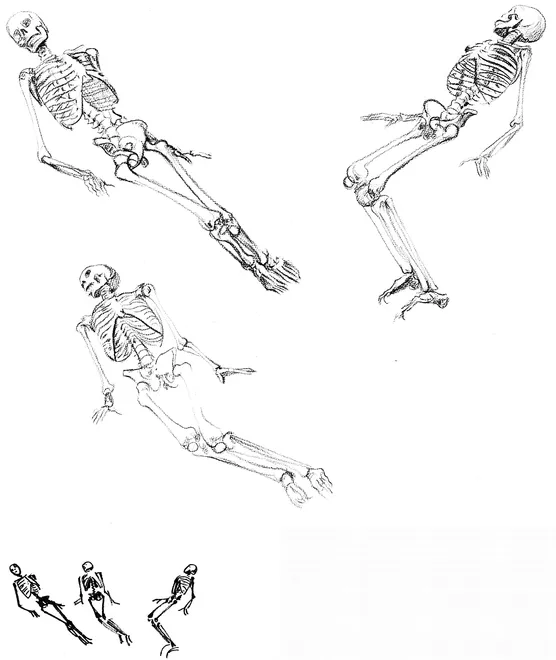
The idea of sketching skeletons in these rather odd positions is to further acquaint the student with the framework of the human figure. Once you have this basic framework well in mind, it will aid you in drawing more convincing figures. At this stage, you need only make little thumbnail sketches, such as those I have included among our drawings of relaxed bones.
Muscles
Once you have become familiar with human bone structure, do a series of sketches from a model. As you draw the figure, preferably from life, try to see where the bones are. Imagine where the rib cage is. Try to locate the scapulae, think of the way the spine bends in the various positions. Later we’ll draw figures and fit the skeleton into them, and vice versa. Now, before studying the main muscles, we’ll just th...